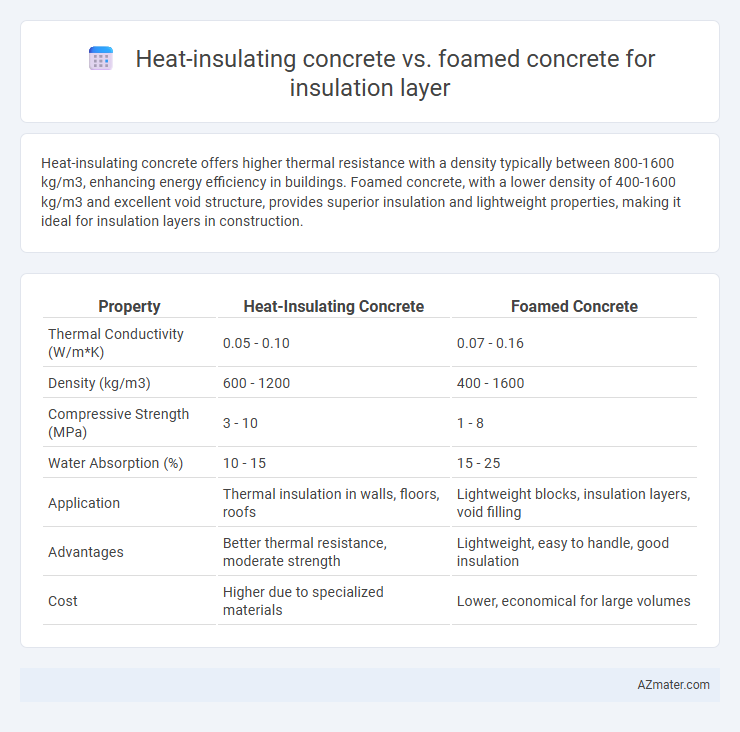Heat-insulating concrete offers higher thermal resistance with a density typically between 800-1600 kg/m3, enhancing energy efficiency in buildings. Foamed concrete, with a lower density of 400-1600 kg/m3 and excellent void structure, provides superior insulation and lightweight properties, making it ideal for insulation layers in construction.
Table of Comparison
| Property | Heat-Insulating Concrete | Foamed Concrete |
|---|---|---|
| Thermal Conductivity (W/m*K) | 0.05 - 0.10 | 0.07 - 0.16 |
| Density (kg/m3) | 600 - 1200 | 400 - 1600 |
| Compressive Strength (MPa) | 3 - 10 | 1 - 8 |
| Water Absorption (%) | 10 - 15 | 15 - 25 |
| Application | Thermal insulation in walls, floors, roofs | Lightweight blocks, insulation layers, void filling |
| Advantages | Better thermal resistance, moderate strength | Lightweight, easy to handle, good insulation |
| Cost | Higher due to specialized materials | Lower, economical for large volumes |
Introduction to Concrete-Based Insulation Materials
Heat-insulating concrete and foamed concrete are advanced concrete-based insulation materials designed to enhance thermal efficiency in construction. Heat-insulating concrete incorporates lightweight aggregates and insulating additives to reduce thermal conductivity while maintaining structural strength. Foamed concrete features a lower density due to air bubbles introduced during mixing, providing excellent thermal insulation and fire resistance for building insulation layers.
What is Heat-Insulating Concrete?
Heat-insulating concrete is a specialized type of concrete designed to reduce heat transfer through its thermal resistance properties, achieved by incorporating lightweight aggregates or insulating materials such as expanded perlite, vermiculite, or glass beads. Unlike foamed concrete, which relies on air bubbles created by foaming agents to provide insulation, heat-insulating concrete focuses on the intrinsic thermal conductivity of its components to maintain stable indoor temperatures. This material is commonly used in building envelopes, roofing, and flooring systems to improve energy efficiency by minimizing heat loss or gain.
Understanding Foamed Concrete for Insulation
Foamed concrete is a lightweight, porous material created by mixing cement slurry with a stable foam, resulting in a structure rich in air bubbles that provide excellent thermal insulation properties. This material offers superior heat resistance due to its low thermal conductivity, making it highly effective for insulation layers in construction. Compared to traditional heat-insulating concrete, foamed concrete also benefits from better fire resistance, sound absorption, and reduced structural load.
Key Material Properties Comparison
Heat-insulating concrete features a low thermal conductivity typically ranging from 0.1 to 0.2 W/m*K, high compressive strength between 5 to 20 MPa, and enhanced durability due to dense microstructure. Foamed concrete offers superior thermal insulation with conductivity as low as 0.05 W/m*K and much lighter density, often between 300 to 1200 kg/m3, but generally exhibits lower compressive strength around 1 to 7 MPa. Moisture resistance is higher in heat-insulating concrete, while foamed concrete's porosity improves insulation but may require additives or coatings for enhanced durability.
Thermal Conductivity: Heat-Insulating vs Foamed Concrete
Heat-insulating concrete typically exhibits thermal conductivity values ranging from 0.1 to 0.3 W/m*K, offering effective resistance to heat transfer compared to conventional concrete. Foamed concrete achieves even lower thermal conductivity, often between 0.05 and 0.15 W/m*K, due to its air-filled cellular structure that enhances insulation properties. The lower thermal conductivity of foamed concrete makes it more suitable for insulation layers in energy-efficient building applications.
Installation Methods and Construction Techniques
Heat-insulating concrete typically requires traditional formwork and vibrating methods for proper compaction, ensuring a dense and uniform insulation layer. Foamed concrete employs a flowable, self-leveling mix with foam agents that simplify pouring and reduce the need for mechanical compaction, allowing faster installation on uneven surfaces. Both materials demand careful curing, but foamed concrete's lightweight and plasticity facilitate easier integration into complex geometries compared to the more rigid handling requirements of heat-insulating concrete.
Mechanical Strength and Load-Bearing Capabilities
Heat-insulating concrete generally offers higher mechanical strength and superior load-bearing capabilities compared to foamed concrete, making it suitable for structural insulation layers in heavy-duty applications. Foamed concrete, while providing excellent thermal insulation due to its high porosity and lightweight nature, typically exhibits lower compressive strength, limiting its use to non-load-bearing insulation layers. Optimizing the mix design can enhance foamed concrete's strength, but heat-insulating concrete remains preferable where structural integrity is critical.
Cost Analysis and Economic Feasibility
Heat-insulating concrete generally offers higher thermal resistance and durability but comes with a greater initial investment compared to foamed concrete, which is more cost-effective due to lower material and production expenses. Foamed concrete's lightweight nature reduces transportation and labor costs, enhancing overall economic feasibility for large-scale insulation projects. Evaluating life-cycle costs reveals foamed concrete as a budget-friendly option for insulation layers, while heat-insulating concrete provides long-term energy savings ideal for projects prioritizing sustainability.
Environmental Impact and Sustainability
Heat-insulating concrete and foamed concrete both offer energy-efficient insulation solutions, with foamed concrete typically showing a lower environmental impact due to its lightweight properties and reduced raw material consumption. Foamed concrete's high porosity improves thermal insulation, decreasing the need for additional heating or cooling and thus lowering carbon emissions over a building's lifecycle. Heat-insulating concrete often incorporates recycled materials but generally has a higher density and embodied energy, making foamed concrete a more sustainable option for insulation layers in green construction projects.
Best Applications: Choosing the Right Concrete for Your Project
Heat-insulating concrete offers superior thermal resistance and durability, making it ideal for structural applications such as walls and floors requiring long-term insulation and load-bearing capacity. Foamed concrete, characterized by its lightweight and high porosity, excels in non-structural insulation layers, roof insulation, and void filling where ease of placement and thermal performance are essential. Selecting the right concrete depends on project-specific requirements like compressive strength, thermal conductivity, and moisture resistance to ensure optimal energy efficiency and structural integrity.

Infographic: Heat-insulating concrete vs Foamed concrete for Insulation layer
 azmater.com
azmater.com